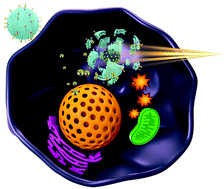Cell-derived nanomaterials have received extensive attention due to their ability to mimic partial natural characteristics originating from source cells. Herein, the red blood cell (RBC) membrane camouflaged core–shell upconversion/mesoporous silica nanoparticles (UCNPs@mSiO2 NPs) were fabricated for synergistic chemophotodynamic therapy. The mesoporous silica shell was covalently grafted with photosensitizer Chlorin e6 (Ce6) and physically adsorbed chemotherapeutic drug doxorubicin (DOX). The bionic nanoplatform possessed the excellent biocompatibility and immune escaping capabilities from the RBC membrane, high specific surface area from the mesoporous silica, and the multicolor emission capability from the UCNPs. Upon excitation, a 980 nm laser was converted to visible light via UCNPs (NaYF4:Yb,Er@NaYF4) to trigger Ce6 to produce singlet oxygen (1O2), not just for photodynamic therapy (PDT), but also for stimulating RBC membrane cleavage and on-demand DOX release for chemotherapy. In vivo, the tumor growth inhibition ratio of synergistic chemophotodynamic therapy was 1.6 and 1.7 times higher than that of single chemotherapy and PDT, respectively.

